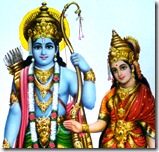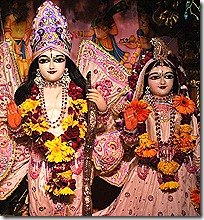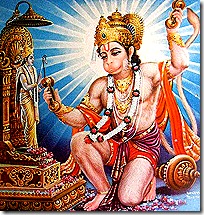 “Reaching that honored city, which was protected by the arms of the ten-headed Ravana, roaming about and not finding that highly respected daughter of King Janaka, who was won over by her husband’s divine qualities, that monkey then became highly distressed.” (Valmiki Ramayana, Sundara Kand, 7.16)
“Reaching that honored city, which was protected by the arms of the ten-headed Ravana, roaming about and not finding that highly respected daughter of King Janaka, who was won over by her husband’s divine qualities, that monkey then became highly distressed.” (Valmiki Ramayana, Sundara Kand, 7.16)
tataḥ sa tām kapir abhipatya pūjitām |
caran purīm daśa mukha bāhu pālitām |
adṛśya tām janaka sutām supūjitām |
suduhkhitām pati guṇa vega nirjitām ||
caran purīm daśa mukha bāhu pālitām |
adṛśya tām janaka sutām supūjitām |
suduhkhitām pati guṇa vega nirjitām ||
Those intimately associated with the Supreme Personality of Godhead substantiate their exalted position and remain steadfast to their occupational duty of being a lover of God not due to any outside obligation or social convention. The roles of brother, son, wife, father, mother, friend, and so on carry many responsibilities. It is said that “a friend in need is a friend indeed”, which means that a good friend is one who is around to help you through the bad times. Being a friend during times of peace is a lot easier than riding out the struggles with your good buddy who is in major distress. A real friend is always there for you, as they are attracted by your qualities and drawn to your association. With a wife, there is an inherent duty that she be there for the husband to support him. This is especially true when the marriage has been arranged by the parents and the couple married under religious principles. Lest we think that this was the main cause for Sita’s devotion to Rama, in the above referenced verse it is declared that she was drawn to Rama by His nature, won over by His divine qualities, orgunas. In this respect she became even more worthy of honor and worship from Shri Hanuman
 Sita’s glories actually know no end. To describe her only as the most beautiful woman in the world would be to shortchange her other qualities, which include kind-heartedness and benevolence. Anyone who is dedicated in thought, word and deed to the Supreme Lord can never be lacking in divine qualities. Scholars not of the bhakti attitude will try to compare Sita to characters from fictional literature and mythological traditions, but the search for anyone even similar to her will be a futile one. Sita is as real as the sun and her glories as everlasting as the infinite nature of time and space. Though she is endowed with every virtuous quality to an immeasurable extent, the devotees still try to describe some of her features and glorify her character, for this brings great joy to the heart. This joy is especially needed during times of distress, when success in a difficult task doesn’t seem certain.
Sita’s glories actually know no end. To describe her only as the most beautiful woman in the world would be to shortchange her other qualities, which include kind-heartedness and benevolence. Anyone who is dedicated in thought, word and deed to the Supreme Lord can never be lacking in divine qualities. Scholars not of the bhakti attitude will try to compare Sita to characters from fictional literature and mythological traditions, but the search for anyone even similar to her will be a futile one. Sita is as real as the sun and her glories as everlasting as the infinite nature of time and space. Though she is endowed with every virtuous quality to an immeasurable extent, the devotees still try to describe some of her features and glorify her character, for this brings great joy to the heart. This joy is especially needed during times of distress, when success in a difficult task doesn’t seem certain.
When the couple was acting out their dramatic roles on this earth many thousands of years ago, one of the acts involved a period of separation. Lord Rama
“Those with the vision of eternity can see that the soul is transcendental, eternal, and beyond the modes of nature. Despite contact with the material body, O Arjuna, the soul neither does anything nor is entangled.” (Lord Krishna, Bhagavad-gita, 13.32)
If we do see someone excel in a particular field, it is to be understood that they are fortunate. Their luck is good because they have been able to perform without impediment, without injury, and without loss of skill. They were also able to defeat their competitors, which means that the laws of nature did not place anyone in their way who could have defeated them. We may think we have control over our own actions, but we certainly can’t manage the behavior of others. Everything is placed into just the right circumstance to have the proper result always manifest.
 God is described as Bhagavan because His fortune is higher than anyone else’s . He is the most beautiful, wise, strong, renounced, wealthy and famous. He is the reservoir of all pleasure and good fortune. When He appears on earth for whatever reason, these divine qualities come with Him. Therefore even when playing the role of the prince of the Raghu dynasty, Bhagavan retained His supreme standing.
God is described as Bhagavan because His fortune is higher than anyone else’s . He is the most beautiful, wise, strong, renounced, wealthy and famous. He is the reservoir of all pleasure and good fortune. When He appears on earth for whatever reason, these divine qualities come with Him. Therefore even when playing the role of the prince of the Raghu dynasty, Bhagavan retained His supreme standing.
Just as the original Personality of Godhead can descend to earth and maintain His stature, the Lord’s eternal consort also comes with Him. The distinguishing feature of the eternal consort is that she gives more pleasure to Bhagavan than anyone else. We could search the three worlds and every inch of space and never find anyone who gives more pleasure to Rama than Sita. She played the role perfectly of a devoted wife, married to Rama after a wonderful ceremony held in the kingdom of Videha ruled by King Janaka, Sita’s father.
Since Rama won Sita’s hand in marriage after lifting and breaking a powerful bow coming from Lord Shiva
Since the male species dominates the female, the duty applied to the wife is to be subservient to and supportive of her husband. This maintains the harmony within the marriage, as the male ego is very strong. Should the wife become predominant, the male ego gets bruised and problems arise. In reality, in most homes where happily married couples reside, the wife runs the show. It’s just that in good marriages the wife acts in such a way that the husband thinks that he is in charge. When both parties follow their prescribed duties, there is a better chance of advancing in consciousness.
 Since Sita and Rama live forever in each other’s company, they don’t require adherence to dharma. In fact, they are the very objects of virtue and piety, as they are regularly remembered by those who follow bhagavata-dharma, or devotional service
Since Sita and Rama live forever in each other’s company, they don’t require adherence to dharma. In fact, they are the very objects of virtue and piety, as they are regularly remembered by those who follow bhagavata-dharma, or devotional service
While on earth, Sita abided by her religious duties perfectly. Rama had a biological mother and two other mothers who were married to His father King Dasharatha. In this sense Sita inherited three mother-in-laws at the time of marriage. Yet she never failed to please any of them, honoring them as she would her own mother on a daily basis. More than anything, she was very chaste and wholly dedicated to Rama. This was done not out of duty necessarily, but more out of love for her husband. Rama’s divine qualities won Sita over, as they had previously done with Lakshmana
“I am His younger brother, Lakshmana by name. Due to His transcendental qualities, I have taken up service to Him, as He is grateful and very knowledgeable.” (Lakshmana speaking to Hanuman, Valmiki Ramayana, Kishkindha Kand, 4.12)
Shri Lakshmana, Rama’s younger brother, was inseparable from Rama since childhood. Again, a younger brother’s duty as espoused by the Vedas is to worship the older brother and treat him like a father. In this respect Lakshmana was wholly deferent to dharma. But when he met Shri Hanuman, Lakshmana made sure to tell him that he was following Rama through thick and thin because of the Lord’s qualities. Twelve years after his marriage to Sita, Rama was ordered to leave the kingdom and not come back for fourteen years. Sita and Lakshmana insisted on accompanying Him, and while in the forest Sita would be kidnapped by a Rakshasa named Ravana. Rama and Lakshmana met up with Hanuman in Kishkindha after that.
 Hanuman was the chief minister of the monkey-king Sugriva, so when he met Rama for the first time, there was also an underlying duty guiding his behavior. Sugriva tasked Hanuman with finding out what Rama and Lakshmana wanted, for their presence as fighters was conspicuous in a forest inhabited by animals and monkeys. Nevertheless, when Hanuman met Rama, he eventually forgot his initial purpose and instead became overwhelmed by the Lord’s brilliant qualities. Right then he decided that Rama was his object of worship and that he would dedicate his life to Him.
Hanuman was the chief minister of the monkey-king Sugriva, so when he met Rama for the first time, there was also an underlying duty guiding his behavior. Sugriva tasked Hanuman with finding out what Rama and Lakshmana wanted, for their presence as fighters was conspicuous in a forest inhabited by animals and monkeys. Nevertheless, when Hanuman met Rama, he eventually forgot his initial purpose and instead became overwhelmed by the Lord’s brilliant qualities. Right then he decided that Rama was his object of worship and that he would dedicate his life to Him.
Jumping forward to when Hanuman was in Lanka searching for Sita, we see that he became dejected upon not finding her right away. Indeed, Hanuman saw everything there was to see in Lanka. The kingdom was extremely opulent, richer than any city seen today. Even the floors were inlaid with jewels and the buildings made of gold. Who could imagine such opulence? Though he appreciated this beauty, Hanuman was still dejected that he had yet to find Sita, who was the reason for his being in Lanka.
In the above referenced verse from the Ramayana it is said that Hanuman was dejected upon not having met the daughter of King Janaka. Amongst kings in the world at the time Janaka was one of the most respected. Initially well known for his mastery over mystic yoga, Janaka would later find a higher sensation by gaining Shri Rama as a son-in-law. Today Janaka is listed as one of the twelve authorities on devotional service. Therefore his daughter Sita would naturally be very exalted as well. It is also mentioned that Sita was well-worshiped. Though she was being held against her will in Lanka, she was the real precious gem in the city, not like the opulence that served as a façade to mask the dedication to the mode of ignorance of the residents. Despite their wealth, Ravana and the Rakshasas lived lives that were devoid of any meaning. Drinking wine and having illicit sex
 Sita had been conquered by the force of her husband’s qualities. Rama’s kindness, beauty, smiling face, and loving heart had won Sita over for life. In this sense her being drawn to Him represented another wonderful quality. Anyone who can say they have been subjugated by Bhagavan’s qualities can be considered highly fortunate. Many exalted saints and divine figures are also referred to as Bhagavan for this very reason. Rishi Narada knows no other business except glorifying Rama and spreading the nectar of His holy name across the world. Hence he is often referred to as Bhagavan, as is Lord Shiva, who is an expert on devotion to Rama, as he practices it as his primary business in life.
Sita had been conquered by the force of her husband’s qualities. Rama’s kindness, beauty, smiling face, and loving heart had won Sita over for life. In this sense her being drawn to Him represented another wonderful quality. Anyone who can say they have been subjugated by Bhagavan’s qualities can be considered highly fortunate. Many exalted saints and divine figures are also referred to as Bhagavan for this very reason. Rishi Narada knows no other business except glorifying Rama and spreading the nectar of His holy name across the world. Hence he is often referred to as Bhagavan, as is Lord Shiva, who is an expert on devotion to Rama, as he practices it as his primary business in life.
Sita’s wonderful qualities only increased Hanuman’s grief over not having found her. At the same time, the separation made him even more eager to search for her, through thick and thin, through both the good times and the bad. Ravana was very powerful, but he was not able to stop someone as devoted as Hanuman from finding the person who gives Rama more pleasure than anyone else. Just as Sita was won over by Rama’s qualities, Hanuman was eternally attached to Sita because of her level of devotion. In the same manner, the sincere souls hearing the tradition of the Ramayana and following the methods of worship instituted by the Vaishnava acharyas can’t help but be won over in the heart by Hanuman’s wonderful exhibition of devotion and dedication. One of Bhagavan’s many qualities is that He is unbeatable, or unconquerable. When the devoted soul makes their life’s mission the pleasing of Bhagavan, that same invincibility is passed on to them. Therefore Hanuman never had a chance of failing in his mission, and neither does anyone who is fortunate enough to hear about Rama’s most faithful servant on a regular basis.
In Closing:
The beloved daughter of Janaka in Lanka waits,
For her husband to rescue her from her dire straits.
Hanuman, from Kishkindha was sent,
Much time in Ravana’s land he spent.
Looking for Sita, to bring the news to her,
That Rama’s arrival in Lanka soon to occur.
But not finding that woman highly blessed,
Hanuman felt temporarily distressed.
Her qualities are second to none,
At pleasing Rama she is number one.
As wife devotion to husband from her everyone came to expect,
But more taken by Rama’s qualities was she, brilliant in every respect.
City of Lanka having opulence unimaginable,
Protected by arms of Ravana, strength formidable.
Without sight of princess, difficult for monkey to proceed,
But by remembering Sita, indeed would he succeed.
 “The tongue is like a snake and the mouth like a snake hole for the person who does not chant the holy names of the Lord. Those who have no love for Shri Rama are understood to be bereft of the creator’s favor, says Tulsi.” (Dohavali, 40)
“The tongue is like a snake and the mouth like a snake hole for the person who does not chant the holy names of the Lord. Those who have no love for Shri Rama are understood to be bereft of the creator’s favor, says Tulsi.” (Dohavali, 40) In the verse above, Tulsidas first says that anyone who doesn’t chant the names of Hari essentially has a tongue which is like a serpent and a mouth which is like a serpent hole. The comparison is so extreme that it is even a bit humorous, as it conveys the deep love and affection held by the poet not only for the person addressed in harinama-japa, or the silent
In the verse above, Tulsidas first says that anyone who doesn’t chant the names of Hari essentially has a tongue which is like a serpent and a mouth which is like a serpent hole. The comparison is so extreme that it is even a bit humorous, as it conveys the deep love and affection held by the poet not only for the person addressed in harinama-japa, or the silent  Aside from its ability to purify, chanting the names of Hari is a very pleasurable experience, especially for one who is able to steadily develop their God consciousness. In every other endeavor the instigating factor is the desire for happiness or enjoyment. When engagement or dedication in an activity ceases, it is to be understood that the enjoyment has withered away. If we suck the juice out of sugarcane, we really have no use for the plant anymore. Therefore once one activity gets boring, we will jump to another and try to squeeze the sweetness out of it. With bhakti, however, it is seen that the dedication to chanting and devotional service in general only increases with further practice. This property of spiritual science can never be understood by blunt measurements or deductive reasoning. In the spiritual land, one minus one can equal one, as the Supreme Lord is not limited by any rules of a temporary land governed by matter.
Aside from its ability to purify, chanting the names of Hari is a very pleasurable experience, especially for one who is able to steadily develop their God consciousness. In every other endeavor the instigating factor is the desire for happiness or enjoyment. When engagement or dedication in an activity ceases, it is to be understood that the enjoyment has withered away. If we suck the juice out of sugarcane, we really have no use for the plant anymore. Therefore once one activity gets boring, we will jump to another and try to squeeze the sweetness out of it. With bhakti, however, it is seen that the dedication to chanting and devotional service in general only increases with further practice. This property of spiritual science can never be understood by blunt measurements or deductive reasoning. In the spiritual land, one minus one can equal one, as the Supreme Lord is not limited by any rules of a temporary land governed by matter. In the Bhagavad-gita, the same Hari, in His original form of
In the Bhagavad-gita, the same Hari, in His original form of  The opinion that those who don’t chant the names of Hari have tongues like snakes and mouths like serpent holes seems a bit harsh. After all, we may know many people who are kind, pious, sweet and caring but don’t take part in bhakti. Should we consider their tongues to be like snakes? Let’s think of it this way. If we see a student in a classroom who is nice and polite but does not do any of their homework nor pass their exams, will we say that they are a good student? If we work with someone at the office who never tells a lie and never says a mean word but at the same time fails to complete the tasks assigned to them, would we say that they are a valuable asset to the company?
The opinion that those who don’t chant the names of Hari have tongues like snakes and mouths like serpent holes seems a bit harsh. After all, we may know many people who are kind, pious, sweet and caring but don’t take part in bhakti. Should we consider their tongues to be like snakes? Let’s think of it this way. If we see a student in a classroom who is nice and polite but does not do any of their homework nor pass their exams, will we say that they are a good student? If we work with someone at the office who never tells a lie and never says a mean word but at the same time fails to complete the tasks assigned to them, would we say that they are a valuable asset to the company? Tulsidas states that the creator has been unfavorable to those who don’t have love for
Tulsidas states that the creator has been unfavorable to those who don’t have love for